Common Nouns Category Sorting & Classifying Vocabulary Games and Activities
- PDF
What educators are saying
Also included in
- Teach grammar, vocabulary and thinking skills with these fun Sorting and Classifying Common Nouns & Vocabulary Activities with Noun Cards Bundle. These activities are the perfect way to teach standard vocabulary acquisition and use. The resource includes common nouns vocabulary activities and nPrice $5.25Original Price $7.50Save $2.25
Description
Help your students practice sorting and classifying common nouns in a fun way with these vocabulary activities & games! Students will sort common nouns by category to teach the Common Core Standard of Vocabulary Acquisition and Use in the primary classroom. Several games are included to teach primary students to sort, classify and categorize vocabulary words and to explain how items are classified and categorized as well as the relationships between objects. Common nouns activities begin at the lowest level with sorting and then move on to classifying. These common nouns activities may be done as a whole class, in small groups, or individually in a center. They are great for early finishers, gifted, and ELL students!
Common Nouns Sorting & Classifying - Vocabulary Activities & Games Includes:
- 352 Picture Noun Cards (100 Fry Picture Noun Cards & 252 Common Noun Cards)
- 30 Sorting Mats
- Instructions For Several Games (Old Maid, Go Fish, and Concentration)
- Instructions & Graphic Organizer To Play Guess my Category
- Instructions & Graphic Organizer To Play List-Label
As students create categories using words and pictures, they develop analysis, discrimination, comparison, and logical thinking skills. Identifying similarities and differences helps students see patterns and make connections. Students develop logical reasoning skills when they analyze a group of items and observe their characteristics. They must be able to see patterns and make connections as they sort, group, and classify through comparing things that are similar and contrasting things that display differences.
Common Core Alignment CCSS.ELA-Literacy.L.K.5 With guidance and support from adults, explore word relationships and nuances in word meanings.
- CCSS.ELA-Literacy.L.K.5a Sort common objects into categories (e.g., shapes, foods) to gain a sense of the concepts the categories represent. CCSS.ELA-Literacy.L.1 Language Standards First Grade Vocabulary Acquisition and Use
- CCSS.ELA-Literacy.L.1.5With guidance and support from adults, demonstrate understanding of word relationships and nuances in word meanings.
- CCSS.ELA-Literacy.L.1.5aSort words into categories (e.g., colors, clothing) to gain a sense of the concepts the categories represent.
- CCSS.ELA-Literacy.L.1.5bDefine words by category and by one or more key attributes (e.g., a duck is a bird that swims; a tiger is a large cat with stripes).
- CCSS.ELA-Literacy.L.2 Vocabulary Acquisition and Use
- CCSS.ELA-Literacy.L.2.5Demonstrate understanding of word relationships and nuances in word meanings.
- CCSS.ELA-Literacy.L.2.5aIdentify real-life connections between words and their use (e.g., describe foods that are spicy or juicy).
See What Other Teachers Are Saying…
- One of the best classifying sorts I have seen. Clear, adorable graphics, with words/without. Developmentally leveled and the approach will help my students understand this standard. WOW, thank you, everything I wanted in one package. Thank you
- This is a VERY useful set of pictures for sorting in different areas. EXCELLENT
- My ELLs love this activity and get so excited to complete them!
Need more engaging activities for your classroom? Check these out!:
- Irregular Plural Nouns Games
- Similes and Metaphors PowerPoint Game Show
- Compound Words Fun: I Spy Compound Words!
How to get TPT credit to use on future purchases:
• Please go to your My Purchases page (you may need to log in). Beside each purchase, you'll see a Provide Feedback button. Click it, and you will be taken to a page where you can give a quick rating and leave a short comment on the product. Each time you give feedback, TPT gives you feedback credits to lower the cost of your future purchases. I value your feedback greatly as it helps me determine which products are most valuable for your classroom to create more for you. ☺
Be the first to know about my new discounts, freebies, and product launches:
• Look for the green star next to my store logo and click it to become a follower. Voila! You will now receive email updates about this store. ☺
Terms:
Copyright © Keep ‘em Thinking!, Susan Morrow. This product is intended for classroom and personal use ONLY and may be used only by the original downloader. Copying for more than one teacher, classroom, department, school, or school system is prohibited. You may not distribute or display this product digitally for public view. Failure to comply is a copyright infringement and a violation of the Digital Millennium Copyright Act (DMCA).
Keep 'em Thinking!
Susan Morrow
Connect with Me:






